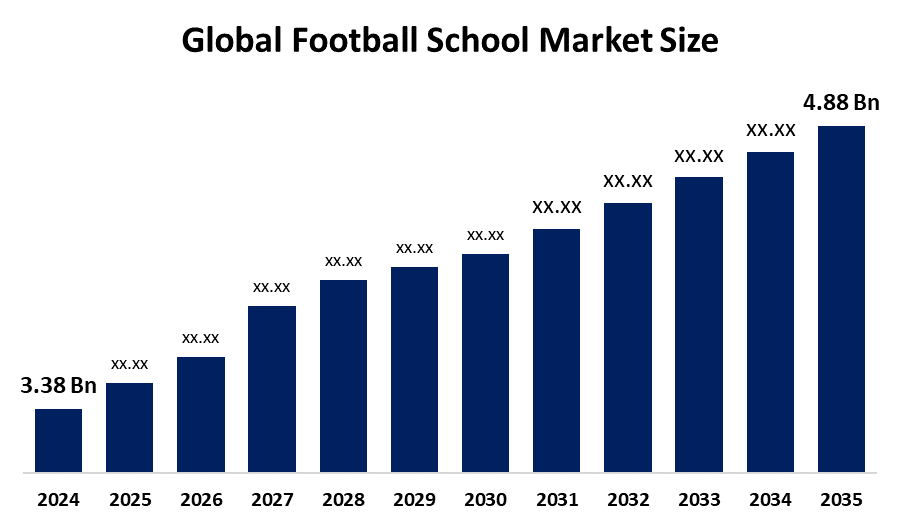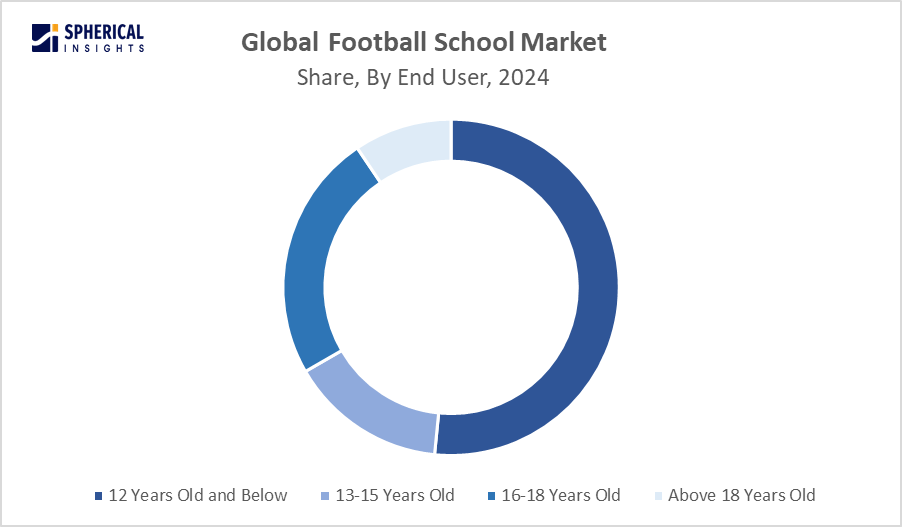Global Football School Market Size, Share, and COVID-19 Impact Analysis, Russia-Ukraine War Impact, Tariff Analysis, By Football School Typology (Elite Professional Academies, Private Commercial Schools/Chains, Community/Non-Profit Clubs & Schools, and School & University Programs), By Type (General Football Schools, and Club Owned Football Schools), By End User (12 Years Old and Below, 13-15 Years Old, 16-18 Years Old, and Above 18 Years Old), and By Region (North America, Europe, Asia-Pacific, Latin America, Middle East, and Africa), Analysis and Forecast 2025 - 2035
Industry: Consumer GoodsFootball School Market Summary, Size & Emerging Trends
According to Spherical Insights, The Global Football School Market Size is Expected to grow from USD 3.38 Billion in 2024 to USD 4.88 Billion by 2035, at a CAGR of 3.4% during the forecast period 2025-2035. The market for football school offers opportunities for developing young talent, organized training plans, collaborations with clubs, academic integration, technology development, international growth, and using education to foster discipline, health, and teamwork.
Key Market Insights

Get more details on this report -
- North America is expected to account for the largest share in the football school market during the forecast period.
- In terms of football school typology, the elite professional academies segment is projected to lead the football school market in terms of equipment throughout the forecast period
- In terms of type, the general football schools segment captured the largest portion of the market
- In terms of end user, the 12-year-old and below segment captured the largest portion of the market
Global Market Forecast and Revenue Outlook
- 2024 Market Size: USD 3.38 Billion
- 2035 Projected Market Size: USD 4.88 Billion
- CAGR (2025-2035): 3.4%
- North America: Largest market in 2024
- Asia Pacific: Fastest growing market
Football School Market
The organized sector that includes schools, academies, and training facilities that offer children, young people, and aspiring professional football players systematic football education and development programs is known as the "football school market." These institutions foster the holistic development of athletes by fusing academic or extracurricular learning with technical, tactical, physical, and psychological training. The football school market consists of both governmental and private organizations, ranging from elite academies connected to professional clubs to grassroots community activities. It includes coaching, talent scouting, support for sports science, and competitive exposure, among other services. For Instance, in July 2025, the Indian Ministry of Education and FIFA launched a nationwide initiative to provide 10 lakh footballs to schools so that students can play soccer wherever in the nation. The market expansion for football school is being driven by the sport's rising appeal globally, particularly in developing nations like Asia and the US. The growing need for professional sports training, investments in sports facilities, and government programs to encourage the growth of young sports are the main factors driving the football school market.
Football School Market Trends
- Technology Integration: To improve player development and coaching efficacy, more data analytics, virtual training platforms, and performance monitoring technologies are being used.
- Globalization and Franchising: The rise of franchised educational models and worldwide football academies allows for uniform training regimens in a variety of geographical areas.
- Academic and Athletic Integration: To promote the overall development of student-athletes, there is an increasing focus on integrating formal education with football training.
- Grassroots & Inclusivity: More funding should be allocated to inclusive projects and grassroots programs that increase underprivileged and marginalized populations' access to football education.
Global Football School Market Report Coverage
| Report Coverage | Details |
|---|---|
| Base Year: | 2024 |
| Market Size in 2024: | USD 3.38 Billion |
| Forecast Period: | 2025-2035 |
| Forecast Period CAGR 2025-2035 : | 3.4% |
| 2035 Value Projection: | USD 4.88 Billion |
| Historical Data for: | 2020-2023 |
| No. of Pages: | 169 |
| Tables, Charts & Figures: | 119 |
| Segments covered: | By Football School Typology, By Type, By End User and By Region |
| Companies covered:: | Ajax, Santos, Sao Paulo, Barcelona, El Semillero, Southampton, De Toekomst, Sporting Lisbon, Bayern Munich, Arsenal Academy, Sporting Academy Alochete, Manchester United Academy, Others. |
| Pitfalls & Challenges: | COVID-19 Empact, Challenges, Future, Growth, & Analysis |
Get more details on this report -
Football School Market Dynamics
Driving Factors: Global tournaments, sponsorships, academies, and developmental catalysts.
Significant international competitions, sponsorship agreements, football clubs' academies, and other factors propelled the football school market expansion. The growing interest in football around the world is one of the main causes, since it has increased the need for organized training and development programs for kids and young people. Football academies and youth development programs are receiving substantial funding from professional football teams and educational institutions in an effort to nurture future talent. Professional football teams and private investors' participation in youngster development programs has also increased access to first-rate facilities and coaching.
Restrain Factors: High costs limit access for lower-income groups.
The high infrastructure and operating costs of the football school market are one of the many restrictions that prevent lower-income groups from participating. Consistent player development may be hindered by a lack of standardized training programs and skilled coaching personnel. The expansion of soccer academies in smaller areas may also be constrained by the expense of maintaining state-of-the-art facilities and hiring top-notch instructors, making it challenging for new players to enroll and access them.
Opportunity: Regional competitions and European ties boost global interaction.
The emergence of regional competitions and international ties with major European clubs also presents a great opportunity to interact with the global football ecosystem and a platform for future potential. Increasing cooperation between academic institutions and professional associations makes it easier to integrate academic and training development. Technological developments improve player results by enabling creative coaching techniques and performance analysis. Football's increasing commercialization and popularity around the world further help the market by opening up new avenues for collaborations, international growth, and income generation.
Challenges: Quality training is scarce in rural areas.
The primary challenge facing the football school market is the scarcity of high-quality training programs and facilities in underserved and rural locations. Inconsistent legal frameworks, budgetary limitations, and restricted access to high-quality infrastructure and qualified coaching are some of the difficulties facing the football school market. Significant challenges to player growth and market expansion also include resolving safety issues, overcoming sociocultural barriers, and striking a balance between scholastic obligations and demanding training.
Global Football School Market Ecosystem Analysis
The ecosystem of the global football school market is made up of a wide range of participants, such as professional teams, football academies, universities, sponsors, governing bodies, and tech companies. These organizations work together to provide thorough training, talent spotting, and development initiatives. Funding sources, changing coaching techniques, and legal frameworks all have an impact on the ecosystem. Integration of technology improves engagement and performance analysis. Global talent exchange and inclusivity are also promoted by grassroots projects and multinational collaborations. The sustainable expansion of football schools is facilitated by this networked environment, which also promotes innovation, commercialization, and the ongoing training of aspiring football players around the globe.
Global Football School Market, By Football School Typology
The elite professional academies segment led the football school market, generating the largest revenue share. The superior infrastructure, extensive player development routes, and close ties to well-known football clubs are the reasons behind the elite professional academies section. Aspiring players and their families find these academies to be the most appealing and dependable choice due to their well-known brands, well-organized curricula, sophisticated scouting networks, and clear paths to professional football advancement.
The private commercial schools/chains segment in the football school market is expected to grow at the fastest CAGR over the forecast period. The growing need for organized, top-notch football instruction outside of conventional club systems is fueling the expansion of the private commercial schools and chains market. These institutions draw a wide range of students with their adaptable curricula, affordable tuition, and frequent integration of contemporary teaching methods and academic support.
Global Football School Market, By Type
The general football schools segment held the largest market share in the football school market. The main factors contributing to the general football school segment are their broad reach, adaptable program designs, and capacity to function separately from professional club systems. General football schools provide scalable business models that may be adjusted to different geographical demands, catering to a wide range of demographics, including novices, recreational players, and those seeking professional growth.
The club owned football schools segment in the football school market is projected to register the fastest CAGR. Strong brand affiliation, access to professional-level training facilities, direct talent pipelines to professional clubs, and rising demand for top football development programs worldwide are the main factors driving the expansion of the club-owned football school segment.
Global Football School Market, By End User
The 12-year-old and below schools segment held the largest market share in the football school market. The primary factors contributing to the 12-year-old and under sector include the expanding focus on early childhood sports education, the growing interest of parents in organized extracurricular activities, and the growing understanding of the early cognitive and physical advantages of football training. Football schools that cater to this age group are quite appealing to families since they frequently emphasize the development of fundamental skills, collaboration, and physical fitness.

Get more details on this report -
The 16-18 years old segment in the football school market is projected to register the fastest CAGR. The growing need for advanced, performance-oriented training as students become ready for professional options or competition at the university level is driving the expansion of the 16–18 age group.
North America is expected to account for the largest share of the football school market during the forecast period. North America is the market leader for football schools in the United States and Canada due to the popularity of soccer in the United States, the region's robust sports culture, and growing investments in youth development. North America's increasing focus on developing domestic talent and its connections to international teams contribute to its growing dominance in the global soccer school market.
The United States is experiencing steady growth in the football school market. The growth of professional club academies, increased investment in football infrastructure, and rising young participation are the main drivers in the US. Furthermore, cooperation with educational institutions and the use of cutting-edge training approaches boost market development.
Asia Pacific is expected to grow at the fastest CAGR in the football school market during the forecast period. The football school market is now dominated by Asia due to the quick development of sports facilities and rising football fandom. Asia is positioned as a significant player in the football school industry as a result of growing awareness of soccer leagues like the Chinese Super League and J-League, which also fuel the demand for professional training and growth.

Get more details on this report -
China is the largest market for football school. China is driven by important government programs designed to encourage the growth of football both at the amateur and professional levels. China's dominant position in the regional football school industry is also a result of its growing interest in football as a national strategic sport and its dedication to combining education and physical training.
Competitive Analysis:
The report offers the appropriate analysis of the key organizations/companies involved within the Football School market, along with a comparative evaluation primarily based on their type of offering, business overviews, geographic presence, enterprise strategies, segment market share, and SWOT analysis. The report also provides an elaborate analysis focusing on the current news and developments of the companies, which includes product development, innovations, joint ventures, partnerships, mergers & acquisitions, strategic alliances, and others. This allows for the evaluation of the overall competition within the market.
WORLDWIDE TOP KEY PLAYERS IN THE FOOTBALL SCHOOL MARKET INCLUDE
- Ajax
- Santos
- Sao Paulo
- Barcelona
- El Semillero
- Southampton
- De Toekomst
- Sporting Lisbon
- Bayern Munich
- Arsenal Academy
- Sporting Academy Alochete
- Manchester United Academy
- Others
Key Target Audience
- Market Players
- Investors
- End-users
- Government Authorities
- Consulting And Research Firm
- Venture capitalists
- Value-Added Resellers (VARs)
Product Launches in the Football School Market
- In August 2025, The Residential Academy, the Center of Excellence, was launched by South United Football Club (SUFC) to empower young Indian football players via top-notch instruction, academic achievement, and all-around growth. Built on progressive training, comprehensive player development, and long-term growth, the Academy offers a high-performance environment that offers a structured pathway to professional football for players in the U-13, U-15, and U-17 age groups.
- In June 2025, the new Football Specialism, a high-performance football route developed in collaboration with Chelsea FC, one of the most successful football teams and brands in the world, was officially launched at Wells Cathedral School. A unique opportunity to combine elite football instruction with top-notch academics and a more comprehensive education will be provided to aspiring football players, both boys and girls, between the ages of 11 and 18 (Years 7–Upper Sixth), through the Wells Cathedral School Football Specialism.
Market Segment
This study forecasts revenue at global, regional, and country levels from 2020 to 2035. Spherical Insights has segmented the football school market based on the below-mentioned segments:
Global Football School Market, By Football School Typology
- Elite Professional Academies
- Private Commercial Schools/Chains
- Community/Non-Profit Clubs & Schools
- School & University Programs.
Global Football School Market, By Type
- General Football Schools
- Club-Owned Football Schools
Global Football School Market, By End User
- 12 Years Old and Below
- 13-15 Years Old
- 16-18 Years Old
- Above 18 Years Old
Global Football School Market, By Regional Analysis
- North America
- US
- Canada
- Mexico
- Europe
- Germany
- UK
- France
- Italy
- Spain
- Russia
- Rest of Europe
- Asia Pacific
- China
- Japan
- India
- South Korea
- Australia
- Rest of Asia Pacific
- South America
- Brazil
- Argentina
- Rest of South America
- Middle East & Africa
- UAE
- Saudi Arabia
- Qatar
- South Africa
- Rest of the Middle East & Africa
Frequently Asked Questions (FAQ)
-
1. What is the CAGR of the football school market over the forecast period?The global football school market is projected to expand at a CAGR of 3.4% during the forecast period.
-
2. What is the market size of the Football School market?The global football school market Size is expected to grow from USD 3.38 billion in 2024 to USD 4.88 billion by 2035, at a CAGR of 3.4% during the forecast period 2025-2035.
-
3. Which region holds the largest share of the football school market?North America is anticipated to hold the largest share of the football school market over the predicted timeframe.
-
4. Who are the top 10 companies operating in the global football school market?Key players include Ajax, Santos, Sao Paulo, Barcelona, El Semillero, Southampton, De Toekomst, Sporting Lisbon, Bayern Munich, Arsenal Academy, Sporting Academy Alochete, Manchester United Academy, and Others.
-
5. What factors are driving the growth of the football school market?The football school market growth is driven by rising global football popularity, increased investments, technological advancements, academic integration, youth development programs, and expanding partnerships between clubs, educational institutions, and governing bodies.
-
6. What are the main challenges restricting wider adoption of the football school market?The primary challenges preventing the market adoption of football schools are expensive infrastructure costs, restricted access in rural regions, a lack of trained coaches, uneven training standards, sociocultural hurdles, and worries about the balance between academics and athletics.
Need help to buy this report?